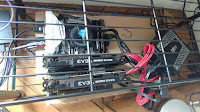Building a custom GPU miner is not
for the person who has never built a PC before. You should practice
building a regular system to gain a basic understanding of PC build
fundamentals. Once that system is stable, then you can move up to the
demands and skills of a custom rig.
You will need basic isolating and troubleshooting skills, which only come with practice. GPU mining is a test of patience and fortitude. Rarely (if ever) can you build a multi card system like this and have it work perfect 100% of the time.
WHAT TO GET: HARDWARE
(Note that I cover this more thoroughly in my last post)
You will need basic isolating and troubleshooting skills, which only come with practice. GPU mining is a test of patience and fortitude. Rarely (if ever) can you build a multi card system like this and have it work perfect 100% of the time.
WHAT TO GET: HARDWARE
(Note that I cover this more thoroughly in my last post)
- a cheap board with enough PCIe slots, cheap HDD (50GB minimum), cheap ram (4Gb is enough)
- a GOOD PSU (for eg I'm running 1200 kW for 4x 1080ti)
- DO NOT buy cheap risers (especially un-powered) as they will fail, sometimes intermittently. Get USB risers as they are more reliable.
- if you have more than 2 cards, build an IKEA rack, milk crate or other custom units otherwise you WILL run into heat issues. There is a good video about this on YouTube where a guy makes a cheap rack out of Ikea parts.
- DO NOT install a side panel on your PC if you are running with more than 1 card. Unless you have very good heat extraction, you will destroy the cards (either the fans or the cards themselves) from 24/7 mining.
- $12 external fan to help with cooling rather than destroy the fans on the GPU, again no side panel.
- you DO NOT need more than x1 speeds, so any x1-x16 slot will do
- x1 riser can go into x16 slot
- (OPTIONAL) remote/wifi-based AC power outlet so that you can remotely turn on/off the unit.
- BIOS updates: first check for latest.
- "above 4g decoding" enabled for multi-card installs, otherwise your other cards may not get detected
- set PCI-e to "gen1". Miners DO NOT need to run x16 speeds - also NO SLI/xfire
- disable ALL other BIOS features you dont need, eg. serial port, audio, etc.
- NO overclocking of CPU or RAM, you want the most STABLE system possible here.
- recommend creating a scheduled task (in task scheduler) to have pc auto reboot once or more a day
- install MSI Afterburner to adjust card internals (eg. 120% power)
- For lazy mining, NiceHash mining - add the program shortcut to the Windows auto startup folder (for W8 and above, use start->run -> "shell:startup")
- as little software as possible, no antivirus, etc.
- avoid motherboard drivers, just use WINDOWS basic drivers for the system
- avoid GPU accessory drivers (3d, physx, etc.) - install JUST the latest driver for the GPU
- lower the screen resolution
- NO NEED TO ACTIVATE WINDOWS 10
- no updates (needs to be disabled manually through Windows 10 "services" )
- power savings - set to HIGH POWER MODE
- vnc / teamviewer / chrome desktop for remote access
- pulseway for optional remote email/text alerting to system offline or rebooting, etc.
- set your VIRTUAL memory to 16GB or more.
- Your cards should be (ideally) pushing 60-75°C temps and your GPU fans around 50%. Running full fans at hot temps is a sure way to wear out the GPU (again, get an external fan)
- Network issues are often solved by rebooting.
- Sometimes cards need to be 'initialized' by connecting a monitor- particularly AMD cards.
- is your PSU up to the task?
- any beep codes?
For most of the issues you come across with a rig, the theme is to ISOLATE as much as possible.
For example if your system shows 3 cards but not 4 - is the 4th card detected in BIOS? Can you connect a HDMI cable to it and see if it displays the BIOS screen? It might be a BOARD issue rather than a GPU issue. Swapping cables and/or physical location on the board would server further to ISOLATE the problem.
For example if your system shows 3 cards but not 4 - is the 4th card detected in BIOS? Can you connect a HDMI cable to it and see if it displays the BIOS screen? It might be a BOARD issue rather than a GPU issue. Swapping cables and/or physical location on the board would server further to ISOLATE the problem.
Keep at it and you'll go from this:
 |
| Humble Beginnings |
To this:
 |
| A Pro in the Making |
